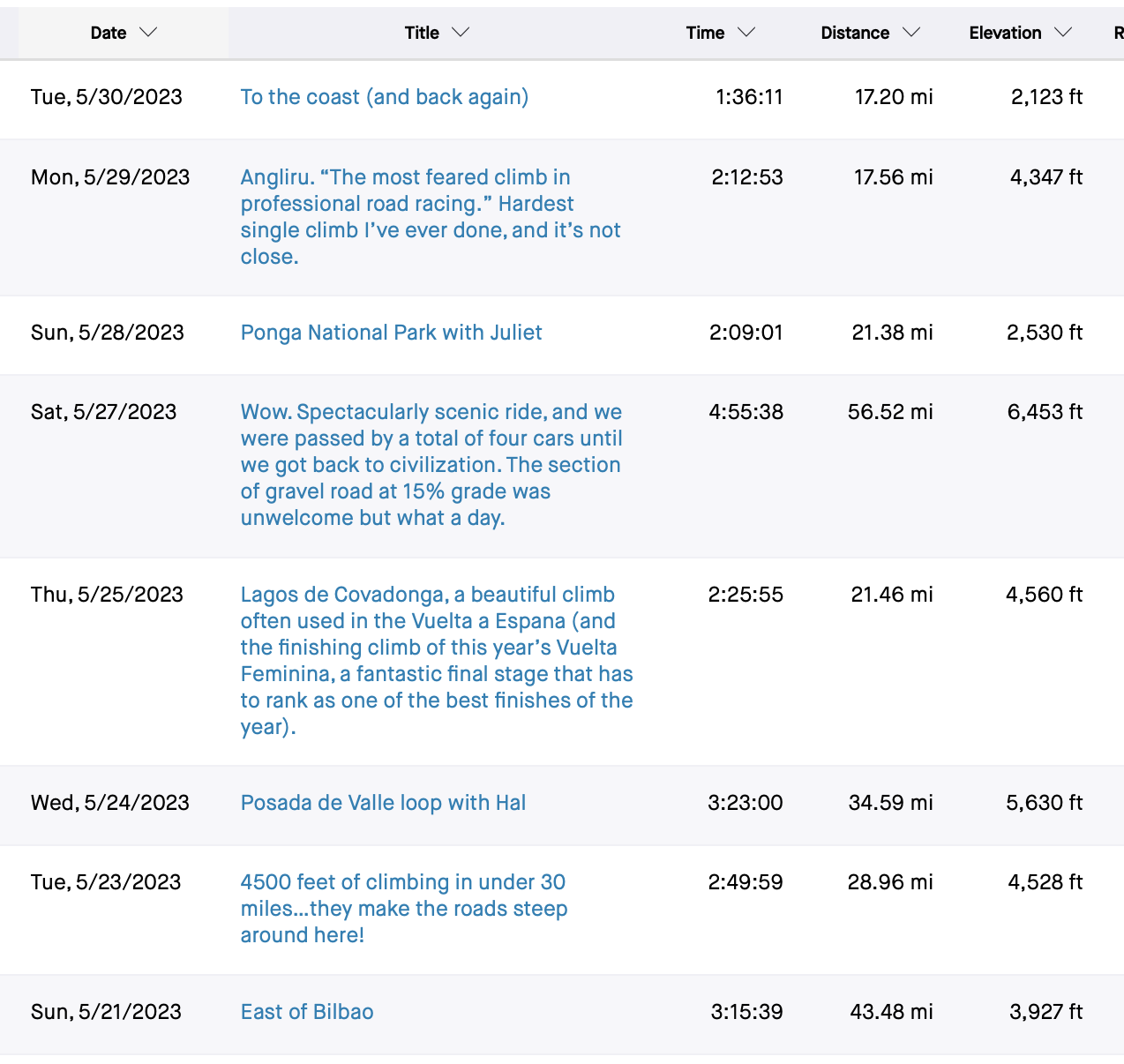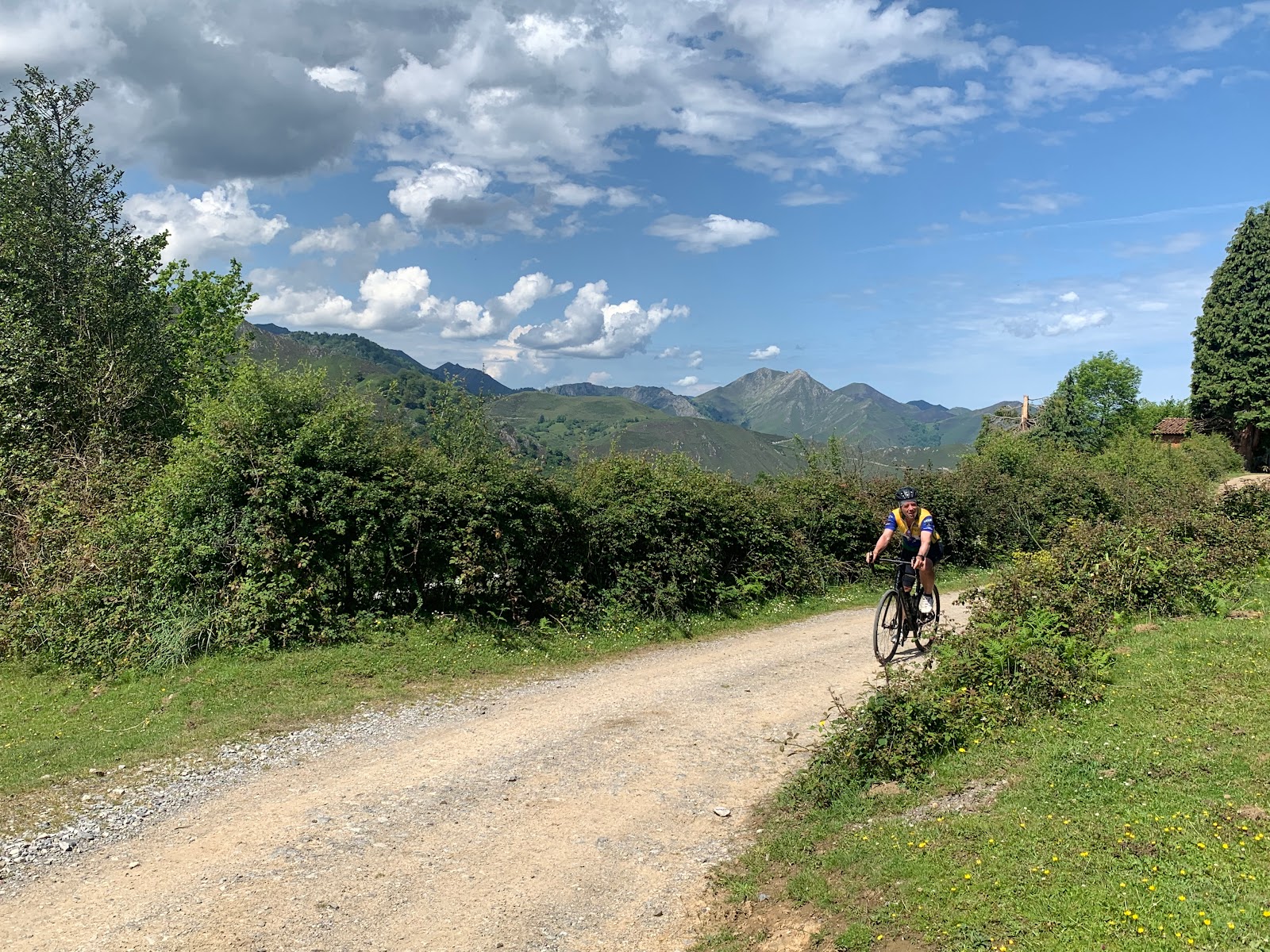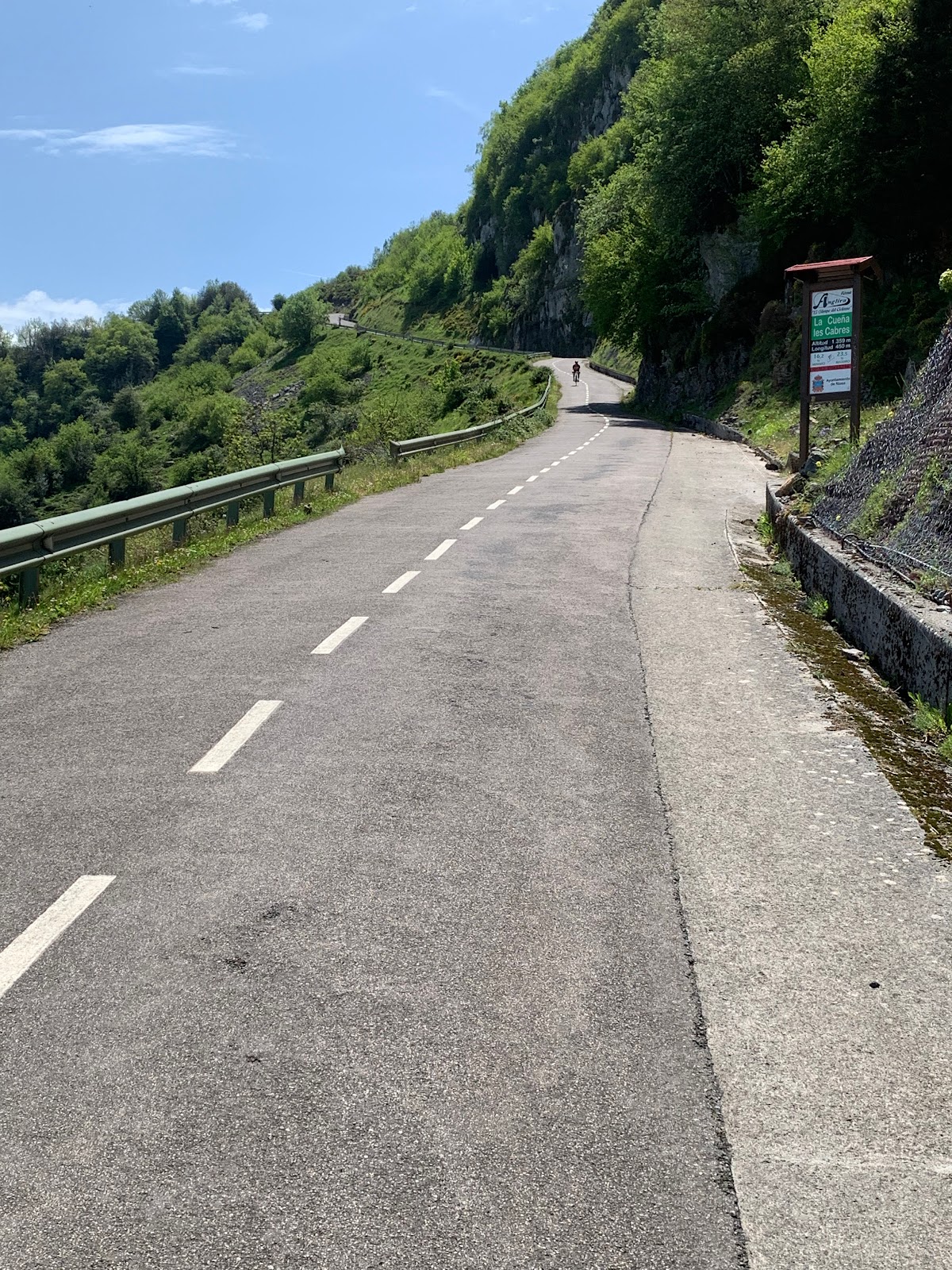Juliet and Phil (and our friends Brigitte and Hal) all did some biking, but Phil is going to write this entry from his perspective.
We rented four nice road bikes from Basque Country Cycling. They are based in San Sebastian but for a reasonable fee they dropped off and picked up the bikes for us in Bilbao. And because we were renting them for 12 days, they gave them to us for 50 Euros per bike per day instead of 60. All of that is good. The bad news is, even though Hal and Brigitte were there for four fewer days than us, we had to rent their bikes for the full period due to the pickup/dropoff issues. I whined about this and Basque Country Cycling knocked a couple of days off their rental. And the bikes were quite nice, although mine quickly developed a loud clicking sound in the bottom bracket and clearly needed an overhaul by the time I returned it. The bikes were all from Orbea (a Spanish manufacturer that also made my mom's E-bike). They were provided with helmets, water bottles, seat bags with multitools, pedals of our choosing (between us we had an eclectic mix of clipless and clip-in shoes) and a few energy bars and extra goodies. All in all it was a good rental, a bit expensive but I couldn't find anywhere cheaper, and BCC were friendly and made sure we had the bikes and accessories we needed.
Juliet and I had a day in Bilbao before Hal and Brigitte arrived, so we each went for a ride. Juliet rode down the river to the industrial port area of the city, while I (Phil) did a loop through the Basque hills that I found on the Strava website (Strava is a website for keeping track of one's fitness activities). The first part of my ride was along some major roads and wasn't so fun, but once I got into the hills it was great: beautiful countryside, nearly no traffic. I didn't take many photos but here are some sheep.
I very much enjoyed all of these, but there are three to mention in particular:
First: "Lagos de Covadonga." Hal and I did this ride starting from our hotel, following a route his Garmin bike computer suggested, which was very similar to one my Wahoo computer suggested (though not identical). Neither of us could convince our computers not to take us on dirt or gravel roads. It's not clear to us whether the software was ignoring our selection of "paved routes only", or whether it thought htese routes were paved. This was mostly not a problem, since we could ride our road bikes on dry dirt or gravel roads just fine, but in a couple of places we had to divert to paved alternatives where our tires wouldn't have been able to handle the computer-generated route.
On one of the dirt roads we encountered this old guy with his shy dog. I cautiously petted the dog and the man and I said good morning and a few other words. With his permission I took his photo, partly because he's wearing traditional wooden shoes. I'm not sure you can tell in the photo -- I didn't want to make the guy feel self-conscious about it so I didn't take a photo of just the shoes. Anyway it was a big surprise to me that someone in the modern era would still choose to wear these. I'm glad, though: it makes the world a bit more interesting when there are still local customs.
Eventually Hal and I reached the bottom of the climb, and up we went. The Lagos de Covadonga climb has been used many times in the Vuelta a Espana bike race (both men's and women's editions) and I had really been looking forward to it. The climb itself is very nice: as is common, it started by following a river valley upwards, then turns off and climbs the forested mountainside, until eventually takes you out of the forest into the high meadows. (There are some photos from the top on the Saturday, June 3 blog entry). Unfortunately there was also quite a bit of traffic and the road is quite narrow. Cars and buses were good about giving us space and waiting until it was at least mostly safe to pass, but it would have been a much more pleasant experience if there were less traffic.
We included some photos from the top in a previous post, but here's another one just to fit in with the narrative. The climb starts at the level of the agricultural lands way down at far right in the photo.
From our hotel to the top was only 22 miles (but 4500 feet of climbing!). Juliet and Brigitte met us at the top and we did a couple of hikes, as previously described. A very nice day.
Once again, we tried using the route selected by our bike computers (or by Google Maps). This time we knew not to trust them: if they tried to put us on a gravel or dirt road that looked too jankety, we were fully prepared to deviate. The first hour or so was terrific: we were immediately routed onto small farm roads that rolled along through the fields and hills... often quite steep (an 8% grade is very typical) but nothing we couldn't handle, and without a single car. Really fantastic; as Hal said, it didn't really matter whether we ended up at our intended destination or not, we could happily ride that way all day. Of course, just ten or fifteen minutes after making that observation we ran into trouble: sure enough, our computer-generated route tried to lead us onto a steep gravel road that didn't look so good. But the roads to left and right also did not look so good. And we were running low on water and would soon need a refill. We asked a guy walking past whether there was a place around to buy a Coke, and he laughed and shrugged and gestured and said something about death. "All the businesses died" is what I thought he said, but Hal thought maybe it was "if you try going that way, you'll die". Anyway we chose a promising-looking direction and set out climbing up a gravel road. The road alternated between gravel (on the relatively flat parts) and concrete with diagonal scoring for traction (on the incredibly steep parts). It was really hard. The gravel honestly wasn't that big an issue, but the steepness certainly was. Finally we reached the top and had a nice view down into the valley, where we could see a paved road. I don't have any photos from the climb but I do have a photo from the spot where I finally said "Hal, we are going to make it."
From there we had a steep descent to the paved road far below, which we joined right at an entrance to Ponga Natural Park. We still needed water. We thought about calling it a day and riding back to the hotel -- we had already had a very nice ride and done a fair bit of climbing and were pretty tired -- but fortunately we decided instead to continue with Plan A: ride into the park and over a mountain pass we had identified on the map. So down, down, down we went into the valley -- stopping at a small intermediate town to pet a cat and fill our water bottles at a fountain -- and eventually we got to the bottom, where there was a restaurant where we each got a couple of Cokes. Then we started riding along a road that followed a stream up the middle of the valley. The scenery was fantastic. I took Juliet back there the next day and we started at the Coke place to do this same part of the ride. I snapped a couple of photos from my bike but they don't look like anything special. You'll have to take my word for it: it was great. And no traffic!
After a few miles, the road heads out of the valley and up the hillside, and so did we. The day Juliet and I were there, we stopped at the very nice small museum in the town of Beleño, halfway up the hill. Both days, after passing through Beleño we continued to the top. Hal and I went over the top and down the other side, whereas Juliet and I turned around here and went back down for lunch at a lovely creekside hotel. Juliet agreed that this was a beautiful place to ride.
For those of us who like fast, scenic descents (this is me!) the descent down the other side was fantastic: the road surface was excellent, the road was curvy enough to be interesting without the curves being dangerously sharp, and there were great views of the rocky, steep-sided canyon.
I don't think Hal loooooved this ride to the extent that I did. For me it was great, top 10, in spite of the pass itself being nothing special. (Not top 5, but hey, can't have everything). It had 90% of the scenic beauty of some of the rides I've done in the Dolomites, Alps, and Pyrenees, with none of the traffic. From the time we left the main road in Arriondas near our hotel, to the time we go to the end of the section photographed above, we saw 5 cars.
WELCOME TO HELL
If there are to be any fireworks, they will come once riders have passed kilometre six - marked on the road by daubing that say ‘Hell starts here’.
From the climb’s halfway point it averages over 13%, with kilometre 11 an eye-watering 17.4%, including sections of ramps that hit 24% - and do not slip below 16.2% - at the 450 metre Cuena les Cabres section.
It is this point that breaks many amateur riders tackling the climb - and at that steepness it is nigh-on impossible to resume riding, leading many to turn around back to the start defeated.
THIS IS INHUMAN
Former Scottish pro David Millar famously refused to finish a 2002 stage that culminated at the climb’s peak, stopping his bike just before the finish line and taking off his rider number in protest. He was eliminated from the race for not finishing the stage. “We’re not animals and this is inhuman,” Millar said at the end of the brutal stage. On that day, Millar crashed descending the Alto del Cordal en-route to the Angliru, and this year riders will take the same route into the summit finish.Oscar Sevilla, who came fourth in that year’s Vuelta, described it as “an inhumane climb.”
Meanwhile former Kelme team manager Vicente Belda went one further, saying: “What do they want, blood? They ask us to stay clean and avoid doping and then they make the riders tackle this kind of barbarity,” when asked about the climb.
For some reason I wanted to do this climb, so I drove to the town of L'Ara, parked the car, and started up the hill. I took it very, very easy on the 1200 or so feet of climbing that it took to bring me to Kilometer 0 of the Angrilu climb itself.
In fact, I took it as easy as I could the whole way: when the road was flat I pretty much coasted along, when the slope was 8% I took it as easy as I could on an 8% grade, and so on. Normally I would tend to push pretty hard on the very steep sections, to get them over with, and then try to catch my breath a bit on the less-steep sections. Fortunately I knew what was coming, so I knew that would take too much out of me. Instead I forced myself to stay very calm and non-aggressive. It all went OK, heart rate mostly under control even on the hard sections...until I got to the "Cuena de Cabres" section mentioned in the quote above. I had just climbed a steep ramp, then got five seconds of easy pedaling at a sort of flat spot in the hairpin turn, and then I found myself facing this ridiculous slope. It looks flat here because I was stupidly pointing my camera parallel to the road rather than horizontally. It is very very steep. It's a pretty safe bet that you've never climbed a slope this steep; and an even safer bet that if you _have_ climbed a slope this steep, it wasn't anywhere near this long. (I took this photo, of another descending rider off in the distance, as I was on the way back down).















This is a great account. The quoted article text, though, is currently too dark to read. I couldn't see it on my phone - didn't even know it was supposed to be there - and could only read it from a desktop computer by cutting and pasting.
ReplyDeleteCongratulations on Angrilu! It all sounds fantastic but especially that.
Ooh, thanks for mentioning! This happened when I cut and pasted from another website, and I've tried tinkering with text color etc. but can't figure out how to fix it...except by changing the background color for the quote, which I've done. Looks a bit ugly but at least you can read it now, I hope.
DeleteYou have pushed yourself and it worked.!!! Congratulations.
ReplyDelete